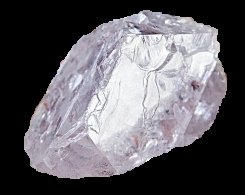
April Editorial
Most diamonds share common origin

April Editorial
Most diamonds share common origin
|
|
How are diamonds made, and what made them? Do the conditions for making diamonds still exist within the Earth? There has been considerable debate among scientists about this, partly because there is so little evidence. A gem-quality diamond is pure crystallized carbon. As a result there is nothing to analyze or get much information from. One way of figuring out how diamonds were formed is to look at their poor relations, fibrous diamonds. As their name suggests, fibrous diamonds contain parallel fibers that are generally oriented in the direction of the diamond’s growth. Although the individual fibers can only be seen under the microscope, most fibrous diamonds can be identified by their dull appearance. This is because particles of other matter (called ‘inclusions’) were trapped within the fibres as the diamonds grew. Numerous microscopic inclusions usually cause fibrous diamonds to be non-transparent or even completely opaque. As you may guess, these diamonds are not the gem-quality stones used in jewelry. Indeed gem-quality monocrystalline diamonds with their perfect transparency and clarity could not look more different than the dull fibrous diamonds. In the past this led has scientists to believe that fibrous diamonds and monocrystalline diamonds originated under different conditions. Fibrous diamonds have always been much easier to study. The impurities inside the crystals provide a lot of vital clues. So we know that fibrous diamonds crystallized deep in the mantle and grew from the carbonate-bearing fluids trapped in their microinclusions. A low level of nitrogen aggregation also suggests that fibrous diamonds are relatively young. The data suggests that they formed just a few million years ago. On the other hand, monocrystalline diamonds are much older. Some are more than 3.2 billion years old. Most monocrystalline diamonds are pure carbon with a perfect crystal cube structure. This makes the study of how those gemstones originated somewhat difficult. To solve this puzzle, Jablon and Navon at the Hebrew University in Jerusalem started the first systematic hunt for microinclusions in monocrystalline diamonds. They focused on twinned crystals. Crystal twinning occurs when two crystals share some of the same crystal lattice points in a symmetrical manner. The result is an intergrowth of two separate crystals. These share a boundary or composition surface. The scientists correctly assumed that if microinclusions were trapped during crystal growth they would be more likely to be trapped along the twinning plane. The researchers examined 30 such diamonds and found microinclusions in eight of them. They found 32 microinclusions in total.
This finding suggests that fibrous diamonds and gem-quality diamonds developed in the same way. This research has been published in Earth and Planetary Science Letters (see reference below). "We're coming full circle on the story," Jablon says. "We can quiet a debate that has been raging in the field for a long time." The research seems to have settled the question of whether fibrous and non-fibrous diamonds have different origins. Because they do not, conclusions about the formation of fibrous diamonds should also be valid for clear diamonds, making the latter indirectly easier to study. Journal Reference: |
| _______________________________ | ||||
| Home | | | Shopping | | | Database |
© Biscuit Software 2004-2015
All rights reserved